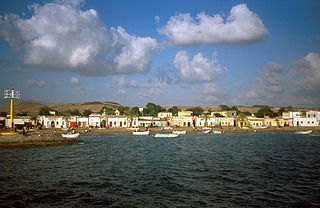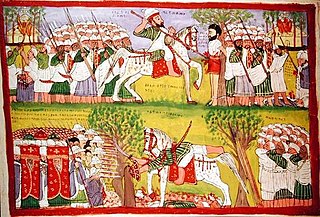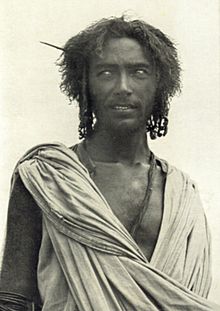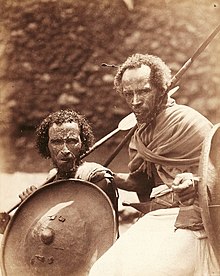
The Horn of Africa (HoA), also known as the Somali Peninsula, is a large peninsula and geopolitical region in East Africa. Located on the easternmost part of the African mainland, it is the fourth largest peninsula in the world. It is composed of Somalia, Djibouti, Ethiopia, and Eritrea. Although not common, broader definitions include parts or all of Kenya and Sudan. It has been described as a region of great geopolitical and strategic importance, since it is situated along the southern boundary of the Red Sea; extending hundreds of kilometres into the Gulf of Aden, Guardafui Channel, and Indian Ocean, it also shares a maritime border with the Arabian Peninsula.

The culture of the Republic of Djibouti is diverse, due to the nation's Red Sea location at a crossroads of trade and commerce.

The Adal Sultanate also known as the Adal Empire, or Bar Saʿad dīn was a medieval Sunni Muslim Empire which was located in the Horn of Africa. It was founded by Sabr ad-Din III on the Harar plateau in Adal after the fall of the Sultanate of Ifat. The kingdom flourished c. 1415 to 1577. At its height, the polity under Sultan Badlay controlled the territory stretching from Cape Guardafui in Somalia to the port city of Suakin in Sudan. The Adal Empire maintained a robust commercial and political relationship with the Ottoman Empire. Sultanate of Adal was alternatively known as the federation of Zeila.

Werner Munzinger was a Swiss adventurer and administrator under the service of the Khedivate of Egypt.

Tadjoura is one of the oldest towns in Djibouti and the capital of the Tadjourah Region. The town rose to prominence in the early 19th century as an alterative port to nearby Zeila. Lying on the Gulf of Tadjoura, it is home to a population of around 45,000 inhabitants. It is the third-largest city in the country after Djibouti and Ali Sabieh.

Asaita (Amharic: አሳይታ, Asayəta; Afar: Aysaqiita), known historically as Aussa (Awsa), is a town in northeastern Ethiopia, and until 2007 served as the capital of the Afar Region of Ethiopia. Located in the Afambo woreda, part of the region's Awsi Rasu zone, the town has a latitude and longitude of 11°34′N41°26′E and an elevation of 300 metres (980 ft).

The Sultanate of Ifat, known as Wafāt or Awfāt in Arabic texts, or the Kingdom of Zeila was a medieval Sunni Muslim state in the eastern regions of the Horn of Africa between the late 13th century and early 15th century. It was formed in present-day Ethiopia around eastern Shewa in Ifat. Led by the Walashma dynasty, the polity stretched from Zequalla to the port city of Zeila. The kingdom ruled over parts of what are now Ethiopia, Djibouti and Somalia.
The Walashma dynasty was a medieval Muslim dynasty of the Horn of Africa founded in Ifat. Founded in the 13th century, it governed the Ifat and Adal Sultanates in what are present-day Somaliland, Somalia, Djibouti, Eritrea and eastern Ethiopia.
Badlay ibn Sa'ad ad-Din II (also known as Sihab ad-Din Ahmad Badlay, Arwe Badlay – "Badlay the Beast" was a Sultan of the Sultanate of Adal and a son of Sa'ad ad-Din II. Brought numerous Christian lands under Muslim rule and contributed to expanding Adal's reach and power in the region. The polity under Sultan Badlay controlled the territory stretching from port city of Suakin in Sudan to covering the whole Afar plains to the Shewa and Chercher Mountains to include significant portions of Somaliland. Sultanate of Mogadishu was also tributary state of Adal under Badlay.
Hadiya also known as Adea or Hadia was a medieval Muslim state in the southern part of its realm located south of Shewa and west of Sharkha. The Hadiya Muslim state mainly composed of Cushitic Hadiyya proper, Halaba, Kebena people as well as Semitic Sil'te and other tongues related to Harari language. Hadiya was historically a vassal state of the Adal federation and then became an autonomous province of Abyssinia in the fourteenth century while still remaining a member of the Zeila union. In the 1600s Hadiya regained its independence and was led by a Garad. By 1850, Hadiya is placed north-west of lakes Zway and Langano but still between these areas.

The Sultanate of Aussa was a kingdom that existed in the Afar Region in eastern Ethiopia from the 18th to the 20th century. It was considered to be the leading monarchy of the Afar people, to whom the other Afar rulers nominally acknowledged primacy.
The Mudaito dynasty is the ruling dynasty of the Sultanate of Aussa in Ethiopia. It was founded by the Asaihemara Modaito clan of the Afars who came from the La'o and Doobi areas.

The Ethiopian–Adal War or Abyssinian–Adal War, also known in Arabic as the "Futuḥ al-Ḥabash", was a military conflict between the Christian Ethiopian Empire and the Muslim Adal Sultanate from 1529 to 1543. The Christian Ethiopian troops consisted of the Amhara, Tigrayans, Tigrinya and Agaw people, and at the closing of the war, supported by a few hundred Portuguese musketmen. Whereas Adal forces were mainly composed of Harla, Somali, Afar, as well as Arab and Turkish gunmen. Both sides at times would see the Maya mercenaries join their ranks.
The Argobba are an ethnic group inhabiting Ethiopia. A Muslim community, they are spread out through isolated village networks and towns in the north-eastern and eastern parts of the country. Group members have typically been astute traders and merchants, and have adjusted to the economic trends in their area. These factors have led to a decline in usage of the Argobba language. Argobba are considered endangered today due to exogamy and destitution as well as ethnic cleansing by the Abyssinian state over the centuries.

Bitwoded Sultan Alimirah Hanfare was Sultan of Aussa from 1944 until his death in 2011. He ascended to the throne after his predecessor and uncle, Mohammad Yayyo.
The Harla, also known as Harala, Haralla are an ethnic group that once inhabited Ethiopia, Somalia, and Djibouti. They spoke the now-extinct Harla language, which belonged to either the Cushitic or Semitic branches of the Afroasiatic family.

The Makhzumi dynasty also known as Sultanate of Shewa or Shewa Sultanate, was a Muslim kingdom in present-day Ethiopia. Its capital Walale was situated in northern Hararghe in Harla country. Its territory extended possibly to some areas west of the Awash River. The port of Zeila may have influenced the kingdom. The rise of the Makhzumi state at the same time resulted in the decline of the Kingdom of Axum. Several engravings dating back to the 13th century showing the presence of the kingdom are found in Chelenqo, Bale, Harla near Dire Dawa and Munesa near Lake Langano.
The Imamate of Aussa, also spelled Imamate of Awsa, was a medieval Sunni Muslim imamate in present-day eastern Ethiopia and north-western Djibouti. Muhammad Gasa established the seat of power to Aussa from Harar in 1577, as the latter was too exposed to Oromo invasions. Internal strife arose from conflicts between the Harla and Arab factions. A Harar faction split from the Imamate in 1647 forming their own independent emirate. The 17th century saw the inclusion of upland Harla and Doba populations playing a pivotal role in the establishment of the Aussa Sultanate. The state was disestablished in 1734 and in 1769, the Mudaito dynasty successfully overthrew the Kabirto of Harla.
The military history of Djibouti encompasses the major conflicts involving the historic empires and sultanates in the territory of present-day Djibouti, through to modern times. It also covers the martial traditions and hardware employed by Djiboutian armies and their opponents.
Adal, known as Awdal or Aw Abdal was a historical Muslim region in the Horn of Africa. Located east of Ifat and the Awash river as far as the coast, and including Harar as well as Zeila. The Zeila state often denoted Adal and other Muslim dominions in medieval texts.

















